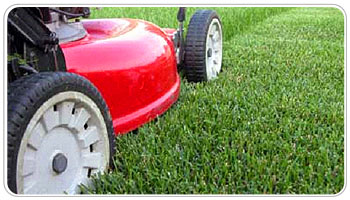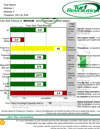Lawn Care Tips

Your lawn should be cut to a height of 3”. More frequent mowing may be needed in spring and fall, never removing more than 1/3 of the grass blade in one cutting. Removing too much of the blade length at one time stresses the grass and weakens your lawn. A longer cutting height results in a stronger, deeper root system and shades the soil retaining moisture and prevents weed seeds from germinating.
Lawn mower blades should be kept razor sharp. A sharp blade makes a clean precise cut which seals quickly and helps resist diseases. A crisp cut is also easier to achieve on a dry lawn rather than a wet one. Try not to cut your lawn during the hottest part of the day. To maintain a razor sharp blade, it maybe necessary to have the blade sharpened multiple times each year. A sharp blade also reduces wear and tear on your lawn mower engine and will increase your mowers gas efficiency. Your cutting pattern should be altered each time as this will keep the grass blades growing straight and strong.
Grass clippings should be left on the lawn when mowing as it is a natural and environmentally friendly practice. Grass clippings are about 90% water by weight. Because they are high in protein they should be left on the lawn to decompose and add nutrients to the soil. The use of a mulching type mower is ideal for grass‑cycling as it cuts the clippings smaller and allows for quicker decomposition. Grass‑cycling also reduces waste and conserves landfill space. It is only necessary to remove the clippings if they are long and will smother the lawn.
Most lawns need about 1” to 1 1/2" of water per week. Regular, fairly deep watering is better than daily light sprinklings. Deep watering and allowing the lawn to dry out between watering will force the roots to penetrate deeper in search of moisture. Early morning is the best time to water your lawn so that the leaves can dry slowly and naturally without too much evaporation. Evening watering can promote the spreading of lawn grass diseases. But if it is the only time of day you are allowed to water, then water in the evening, as it is better to water in the evening than no water at all.
An easy way to tell if your lawn needs water is:
- Areas of the lawn especially near sidewalks and driveways, under large trees and on slopes, take on a blue‑green haze. If extremely dry the lawn may appear yellowish.
- Footprints don't spring back shortly after they are made.
Aeration is one of the most beneficial things you can do for your lawn every year. Aeration will help reduce thatch and compaction and let more air and water into the root zone, developing a deep root system. Spring or fall is the best time to aerate as the soil is moist and it will be easier to remove the cores.
Aeration equipment removes small soil cores (plugs) that are left on the lawn to break down. The cores will disappear in 7 to 14 days, depending on the time of year. Aeration may be done 1 or 2 times each year.
As your lawn grows it produces a layer of thatch, just above the soil. Thatch is made up of living, dead and decomposing plants. If the thatch layer becomes to thick the soil beneath can become compacted and it will make it difficult for the roots to grow. It will also limit the movement of air, moisture and nutrients through the soil. Thatch can provide a home for insects and diseases.
Dethatching equipment removes thatch by using a series of knife blades that cut into the thatch layer. The blade removes the thatch by pulling it out of the lawn. The thatch that is removed from your lawn needs to be raked up immediately. A desirable thatch thickness is ½” or less.
The three main ingredients in fertilizer are: Nitrogen, Phosphorus and Potassium. The numbers represent percentages of each nutrient contained in the bag of fertilizer. For example: 30-15-15 means 30% Nitrogen, 15% Phosphorus and 15% Potassium.
Nitrogen is very important and is the most essential nutrient as it is responsible for a lush, green colour and turf vigor. Phosphorus aids in root development which is important when establishing a new lawn. Potassium is necessary for maintaining plant hardiness.
Fertilizer must be applied evenly and at the proper rate to prevent burning or leaving stripes on the lawn. Autumn fertilizing stimulates a lawn to become thick and strong rather than increasing top growth. During the cooler days between August and November plants begin storing nutrients and sugars for the upcoming winter. It is building up its reserves, which will speed up the lawn greening up in the spring.
A light raking in the spring is beneficial to your lawn; it will help in areas that may have become compressed from snow. It is also important to rake if your lawn clippings are long and will smother the lawn. You will need to rake out any dead patches before over-seeding too.
Topdressing is a thin layer of compost and soil spread over the lawn, ½” to 1” thick and any large clumps of topdressing should be broken down. Topdressing is used to level out your lawn, increases micro-organisms and may improve water retention in the soil. An increase in micro-organism activity can reduce the thatch layer in your lawn too. Topdressing is done either by hand or by machine. Topdressing works best after aerating or dethatching but can be done at any time as long as the lawn is actively growing.
Over-seeding means sowing grass seed over your existing lawn. A seed mixture that contains one or more modern varieties of Kentucky bluegrass, fine fescue and perennial ryegrass is recommended. Kentucky bluegrass provides a lush, dark green lawn. Fine fescue is a lighter green grass that blends well with bluegrass and tolerates shadier parts of your lawn. Perennial ryegrass is added because it germinates quickly and is more resistant to turfgrass diseases. Grass seed needs to be kept moist until germination. When watering don’t allow the water to puddle or run off as this will wash your seed away.
You can do more damage than good by rolling a healthy, established lawn. Lawn rolling compacts the soil and prevents good air and moisture flow to the roots. The only time you need to roll your lawn is if it is a newly sodded lawn or newly seeded as this establishes good contact with the soil.
The Top Ten Reasons Your Customer Should Test Their Soil
- Soil Testing saves you money. Stop the costly guesswork, the lab tells you what your lawn needs. Instead of overspending on fertilizers and pesticides, you will now know exactly what products to use and how much of them to use.
- Soil Testing is an effective way to control weeds, insects and disease without using pesticides. Many of these pests are the result of nutrient imbalances or other problems in the soil. Soil testing is the only way to identify and correct these problems. Why not prevent the pests before they get started?
- They're so easy to use. Turf Revolution's Soil Test Kits are easy to use and even easier to understand. Imagine having your own personal laboratory helping you take care of your lawn. Our kits give you that power. They really are science made simple.
- They're so inexpensive. Our convenient postage- paid soil test kits are actually cheaper than getting a soil test done at a lab. Our kits are a small investment in a successful lawn care program.
- Finally, you can track your progress. Performing a soil test every two years will allow you to see how you're improving the soil beneath your lawn. Watch as pH levels and nutrients are slowly optimized for your lawns growth. Go on, get into your lawn.
- You're tired of struggling to make your lawn grow. We've all had those spots in our lawns that just don't want to grow. A soil test will identify the problem and better yet, provide you with the solution. Finally, a thick, beautiful lawn is just one test away.
- Not all lawns are created equal. The soil beneath your lawn may be substantially different from the soil beneath your neighbour's lawn. So why are you using the same approach. The soil under your lawn can be affected by many things such as the type of trees present or the geological properties of the area. Many retailers carry products manufactured in other parts of the country for other types of soil. How can you be sure they're right for your lawn? A soil test is your best guide to success.
- Because you're tired of the endless product pitches and promises. Tired of trying product, after product only to watch your lawn deteriorate? The results from a soil test are from an independent, accredited laboratory. We, at Turf revolution, never see your results nor can we influence the lab. They only care about helping your lawn and their recommendations will be based upon what's best for your lawn and not for our bottom line. To maintain their accreditation their recommendations are based only upon science.
- Because you're a smart, educated consumer. Who has time or money to waste? You want to be sure that what you buy will answer your needs. A soil test ensures that the products you buy for your lawn will work the way that they're supposed to.
- Because this year, you want the best lawn on the street. By focusing on what your lawn really needs, it will be thicker, darker and more beautiful than ever before. Imagine being the envy of your neighbourhood. Make soil testing your key to success.
Sample Soil Test Results
 Sample Soil Test Results
Sample Soil Test Results




